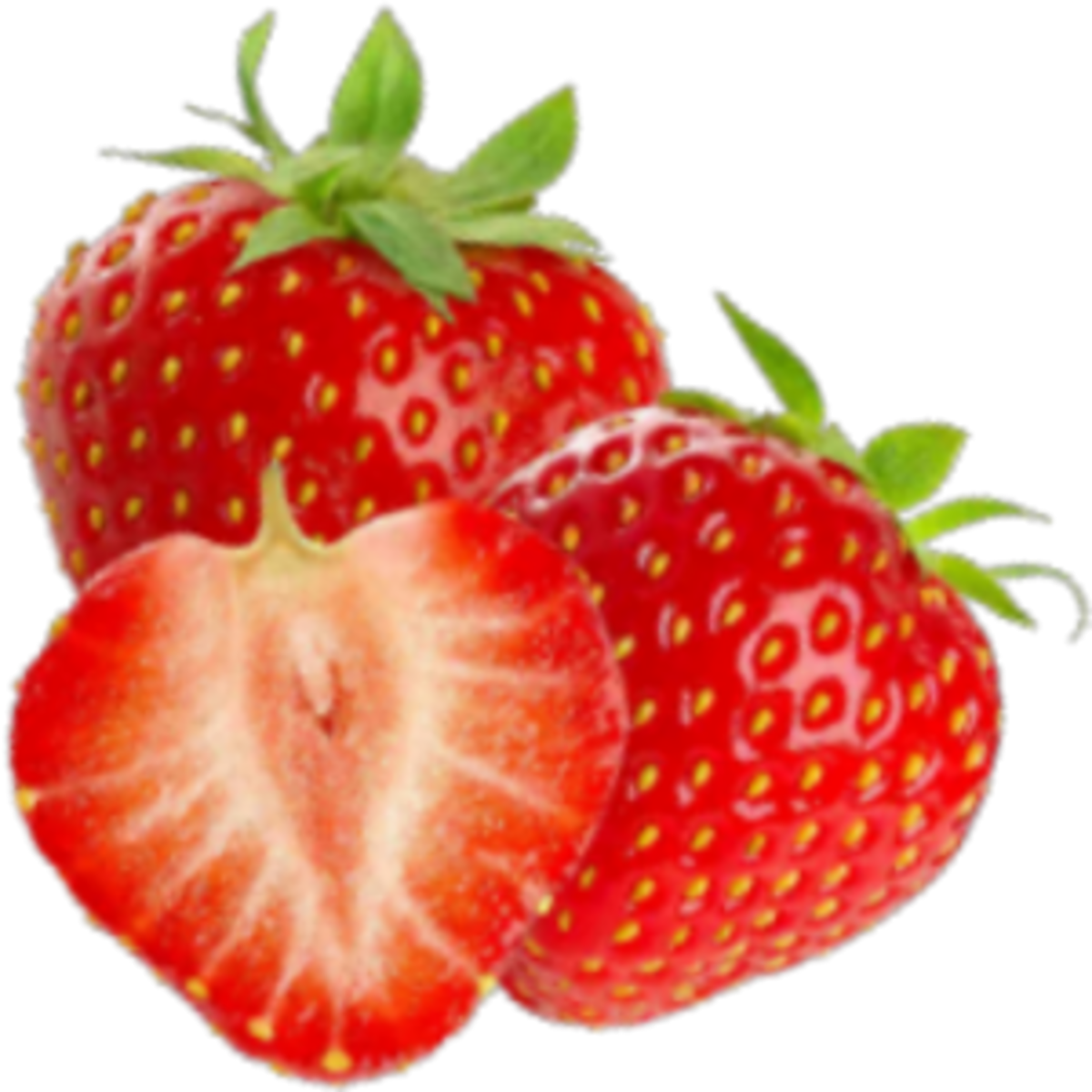

Regular monitoring of nutrient levels such as nitrate (NO3-), potassium (K+) and calcium (Ca2+) in plant petioles, soil solution, irrigation water, and drain water produces not only good yield and fruit quality, but also reduces fertilizer cost and mitigates environmental hazards. The LAQUAtwin pocket meters are the perfect tools for testing as they directly measure samples and provide results in just few seconds allowing growers to identify and correct any nutrient deficiency or excess immediately.
Strawberry production requires a root environment with good availability of essential nutrients to achieve optimum plant growth, fruit quality, and yield. Soil pH influences the availability of nutrients such as nitrate (NO3-), potassium (K+) and calcium (Ca2+) ions, which have specific roles in strawberry fruit quality - NO3- determines the size, K+ influences the taste, and Ca2+ affects the firmness. The nutrients should be present in a right balance to avoid competition or improper plant uptake. Aside from maintaining the correct soil pH for nutrient availability, the conductivity should also be closely and frequently monitored, as strawberry plants do not tolerate high conductivity value.
Plant sap analysis has been used by growers to manage crop nutrient content and fertilization strategies. A plant sap test gives a view of the nutrients available for the plant, at that time, for growth or development. It directly shows if a crop suffers from a nutrient deficiency or an excess. Soil solution analysis is also important for growers. It gives a view of the nutrient and salinity levels in the soil and nutrient leaching past the root zone. Soil solution is the water held in the soil, which contains a mixture of nutrients taken up by roots.
HORIBA offers LAQUAtwin pocket meters which provide reliable and accurate results for plant sap and soil testing parameters such as pH, conductivity (EC), nitrate (NO3-) / nitrate-nitrogen (NO3-N), potassium (K+), calcium (Ca2+) and sodium (Na+). Several research studies have proven that results obtained with LAQUAtwin pocket meters are strongly correlated with those of traditional laboratory analyses. With their unique and compact design, the LAQUAtwin pocket meters allow direct measurement of micro-volume sample (as low as 0.1ml) and deliver results in just a few seconds. These advantages enable growers to make fertilization and irrigation decisions quickly.
Calibrate the LAQUAtwin pocket meters according to manufacturer’s instructions.
For sampling, it is critical to always follow the same protocol and collect the correct tissue in order to get consistent and reliable results. The most recent mature trifoliate leaf is the best indicator of the most essential nutrients for plant growth (e.g., P, K, Ca, etc.) and the petiole from this leaf is the best indicator of NO3-N. Plant temperature should be within 20 to 25°C.

1. Collect 2 most recent mature trifoliate leaves and the associated petioles from 20 different strawberry plants to get a representative sample. The petiole must be detached from the plant near the crown.
2. Separate the petioles from the leaves and cut them into small pieces.
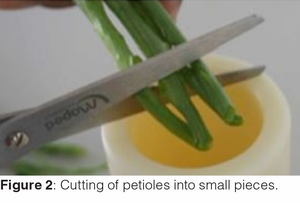
3. Load the small pieces of petioles into a garlic press or hydraulic sap press and squeeze them to extract sap.
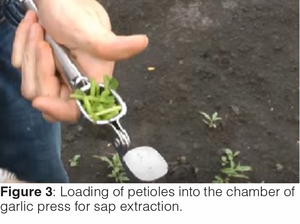
4. Place the sap directly onto the respective sensors of LAQUAtwin nitrate and potassium pocket meters.
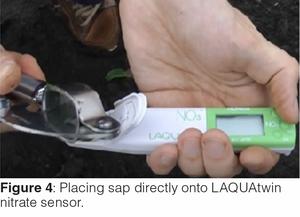
5. Compare the results with the reference values in Table 1 to evaluate the current nutritional condition of the plants and implement the best course of action.
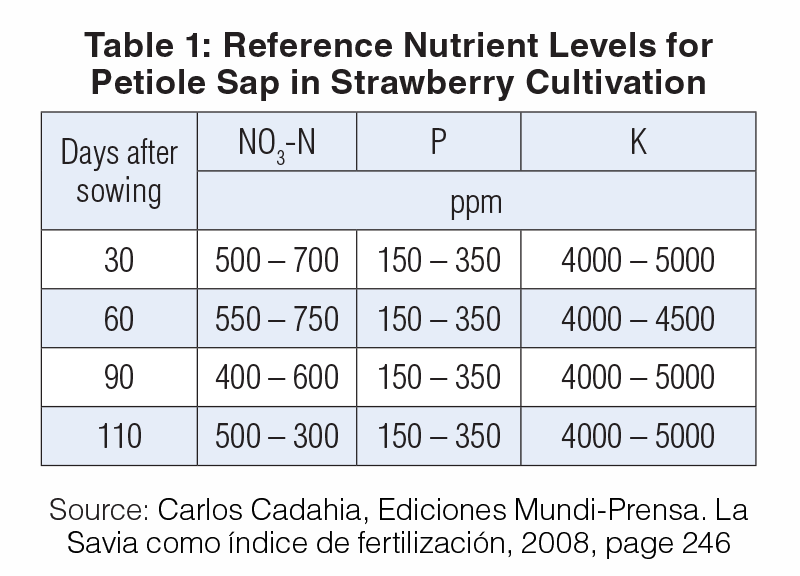
6. Rinse the sensors with clean water before testing another sample or storing them.
Soil solution for pH, salinity (usually reported as conductivity), and nutrient analysis can be extracted through lysimeters installed in the field – at 15-20cm depth, where strawberries have the bulk of their roots and at 50-60cm depth below most of the roots. Lysimeters are installed under vacuum pressure and pull water from the soil similar to the root of the plant. To extract suitable samples, the soil must have been recently wetted with rainfall or irrigation water.
1. Place the sample of extracted soil solution directly onto the respective sensors of LAQUAtwin pH, conductivity, sodium, nitrate, potassium, and calcium meters.
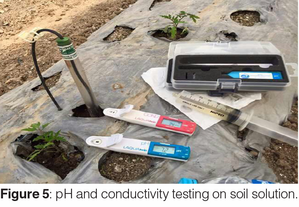
2. Record the results and monitor the nutrients on a weekly basis.
3. Rinse the sensors with clean water before testing another sample or storing them.
Results should be interpreted by comparing trends from season-to-season and block-to-block with strawberry performance indicators such as yield and fruit quality. Irrigation and drain water can also be analysed directly with LAQUAtwin pocket meters.
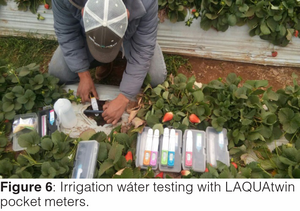
Strawberries have salt tolerance threshold of 1.0 mS/cm and will grow best in soil pH range of 5.5 to 6.5.
Plant sap analysis provides information on the current nutritional status of the plant. This information makes it possible to fine-tune N application, to maximize yield and quality, and to extend the fruiting season. The plant sap analysis complements soil solution analysis.
Soil solution analysis can help growers make decisions about their irrigation and nutrient management program. It should be used to enhance nutrient management and not as a measure of overall soil nutrient status. Nitrate and salinity levels are the key focus of soil solution monitoring. As nitrate is a highly mobile nutrient, soil solution can help identify incorrect nitrogen application, which could result in nitrate accumulation within the root zone and nitrate leaching below the root zone. Potassium and calcium are bound to soil and their levels in soil solution do not provide a reliable indication of their supply and availability to the crop. However, potassium, calcium, and sodium levels in soil, irrigation water, and drain water should be checked regularly. Salinity levels measured in soil solution allow growers to perform corrective action (e.g., increase irrigation to maintain salinity levels) before symptoms appear on leaves, yields or crop quality. Overwatering leaches fertilizer out of the root zone and results in environmental hazard (e.g., groundwater contamination). Soil solution analysis can be tested throughout the growing season.
1. Castellanos, J. Manual de producción de tomate en invernadero. México 2009, p.200-201.
2. Ginés y Simón Navarro García. Química Agrícola, Tercera Edición 2013, p.245
3. Carlos Cadahia, Ediciones Mundi-Prensa. La Savia como índice de fertilización, 2008, page 246
4. Casteel, S. (2004). Strawberry Fertility and Nutrient Management. Available at:
bit.ly/2m1dsqr (Accessed: 27 February 2017).
5. Falivene, S. Soil Solution Analysis. Available at: bit.ly/2lNtukB (Accessed: 5 March 2017).
6. Singh, P. Soil Analysis in Strawberry Farm at Holleta, Ethiopia.
7. FAO Crop Salt Tolerance Data. Available at www.fao.org/docrep/005/y4263e/y4263e0e.htm
Revision 1.0, 6 March 2017
Masz pytania lub prośby? Skorzystaj z tego formularza, aby skontaktować się z naszymi specjalistami.
Pocket Water Quality Meters
Pocket Water Quality Meters
Pocket Water Quality Meters
Pocket Water Quality Meters
Pocket Water Quality Meters
Pocket Water Quality Meters
Pocket Water Quality Meters
Pocket Water Quality Meters
Pocket Water Quality Meters
Pocket Water Quality Meters
